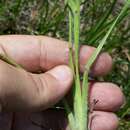Comprehensive Description
provided by North American Flora
Paspalum curtisianum Steud. Syn. Gram. 26. 1854
Paspalum praecox Curtisianum Vasey, Bull. Torrey Club 13 : 165. 1886. Paspalum Kearneyi Nash, in Small, Fl. SEJ. U. S. 77. 1903.
A strongly pubescent perennial with long leaf-blades and glabrous flat spikelets. Stems 8-15 dm. tall; leaf-sheaths strongly hirsute, compressed; blades up to 5 dm. long and often 1 cm. wide, linear, erect, flat, strongly papillose-hirsute, especially above, with long hairs; racemes 5-10, rarely fewer, spreading or ascending, 3-10 cm. long; spikelets single or in pairs, circular, 2.5-3 mm. in diameter, the first scale wanting, the second and third scales 3-nerved, the fruiting scale flat, striately roughened with conspicuous papillae.
Type locality : Carolina.
Distribution : South Carolina to Florida and Mississippi.
- bibliographic citation
- George Valentine Nash. 1912. (POALES); POACEAE (pars). North American flora. vol 17(2). New York Botanical Garden, New York, NY
Comprehensive Description
provided by North American Flora
Paspalum glaberrimum Nash, in Small, Fl. SE. U. S. 76. 1903
JPaspalum amplum Nash, in Small, Fl. SK. U. S. 77. 1903.
A glabrous or sparingly pubescent stout perennial, with long flat leaf-blades and glabrous flat spikelets. Stems 1-1.5 m. tall; leaf-sheaths flattened, the outer basal ones hirsute below, the remainder glabrous, or sometimes hirsute at the apex; blades 3-4 dm. long, 5-8 mm. wide, erect or nearly so, flat, glabrous on the lower surface, the upper surface pubescent; racemes 3-8, erect or ascending, the lower ones commonly 7-15 cm. long, sometimes shorter; spikelets orbicular to oval, 3-3.5 mm. long, 2.5-3 mm. wide, flat on both sides, the first scale wanting, the second and third scales yellowishgreen, 3-nerved, the fruiting scale white, flat, strongly roughened with conspicuous papillae.
Type locality : Southern peninsular Florida. Distribution : Georgia and Florida to Mississippi.
- bibliographic citation
- George Valentine Nash. 1912. (POALES); POACEAE (pars). North American flora. vol 17(2). New York Botanical Garden, New York, NY
Comprehensive Description
provided by North American Flora
Paspalum praecox Walt. Fl. Car. 75. 1788
Paspalum lentiferum lyam. Tab. Encyc. 1 : 175. 1791. Paspalum virgatum Le Conte, Jour, de Phys. 91 : 284. 1820,
A usually slender glabrous perennial, with flat often short leaf-blades, and glabrous; flat spikelets. Stems compressed, 6-12 dm. tall; leaf-sheaths compressed, glabrous; blades 2 dm. long or less, 4-6 mm. wide, linear, erect, flat, glabrous; racemes usually 4—6, rarely more or fewer, ascending, 2-5 cm. long; spikelets in pairs, nearly flat on both sides, yellowish-green, orbicular to oval, 2.2-2.5 mm. long, 1.8-2.2 mm. wide, the first scale wanting, the second and third scales 3-nerved, the fruiting scale fiat, striately roughened with conspicuous papillae.
Type locality : South Carolina.
Distribution : North Carolina to Florida and Texas.
- bibliographic citation
- George Valentine Nash. 1912. (POALES); POACEAE (pars). North American flora. vol 17(2). New York Botanical Garden, New York, NY
Comprehensive Description
provided by North American Flora
Paspalum tardum Nash, in Small, Fl. SE. U. S. 76. 1903
A pubescent perennial, with compressed leaf-sheaths and glabrous flat spikelets. Stems 6-13 dm. tall; leaf-sheaths compressed, the lower and outer basal ones usually more or less pubescent with long hairs, and the others generally so at the apex; blades up to 3 dm. long and 1 cm. wide, erect or nearly so, flat, or folded when dry, hirsute on the upper surface below the middle, increasingly so toward the base where the hairs are very dense and long ; racemes usually 3 or 4, sometimes only 2, rarely more numerous, commonly 3-6 cm. long, sometimes shorter; spikelets single or in pairs, orbicular or nearly so, 2.2-2.5 mm. in diameter, the first scale wanting, the second and third scales 3-nerved, the flowering scale flat, striately roughened with conspicuous papillae.
Type locality : Florida. Distribution : Florida to Texas,
- bibliographic citation
- George Valentine Nash. 1912. (POALES); POACEAE (pars). North American flora. vol 17(2). New York Botanical Garden, New York, NY
Physical Description
provided by USDA PLANTS text
Perennials, Terrestrial, not aquatic, Rhizomes present, Rhizome short and compact, stems close, Stems nodes swollen or brittle, Stems erect or ascending, Stems caespitose, tufted, or clustered, Stems terete, round in cross section, or polygonal, Stem internodes solid or spongy, Stem internodes hollow, Stems with inflorescence less than 1 m tall, Stems with inflorescence 1-2 m tall, Stems, culms, or scapes exceeding basal leaves, Leaves mostly cauline, Leaves conspicuously 2-ranked, distichous, Leaves sheathing at base, Leaf sheath mostly open, or loose, Leaf sheath smooth, glabrous, Leaf sheath hairy, hispid or prickly, Leaf sheath hairy at summit, throat, or collar, Leaf sheath or blade keeled, Leaf sheath and blade differentiated, Leaf blades linear, Leaf blades 2-10 mm wide, Leaf blade margins folded, involute, or conduplicate, Leaf blades mostly glabrous, Leaf blades more or less hairy, Leaf blades scabrous, roughened, or wrinkled, Ligule present, Ligule an unfringed eciliate membrane, Inflorescence terminal, Inflorescence solitary, with 1 spike, fascicle, glomerule, head, or cluster per stem or culm, Inflorescence a panicle with narrowly racemose or spicate branches, Inflorescence with 2-10 branches, Inflorescence branches 1-sided, Rachis dilated, flat, central axis to which spikelets are attached, Flowers bisexual, Spikelets pedicellate, Spikelets dorsally compressed or terete, Spikelet less than 3 mm wide, Spikelets with 1 fertile floret, Spikelets with 2 florets, Spikelet with 1 fertile floret and 1-2 sterile florets, Spikelets paired at rachis nodes, Spikelets all alike and fertille, Spikelets bisexual, Spikelets disarticulating below the glumes, Spikelets secund, in rows on one side of rachis, Rachilla or pedicel glabrous, Glumes present, empty bracts, Glumes 1 clearly pres ent, the other greatly reduced or absent, Glumes distinctly unequal, Glumes equal to or longer than adjacent lemma, Glume equal to or longer than spikelet, Glumes 3 nerved, Lemma similar in texture to glumes, Lemma 3 nerved, Lemma glabrous, Lemma apex truncate, rounded, or obtuse, Lemma awnless, Lemma straight, Palea present, well developed, Palea shorter than lemma, Stamens 3, Styles 2-fid, deeply 2-branched, Stigmas 2, Fruit - caryopsis.

